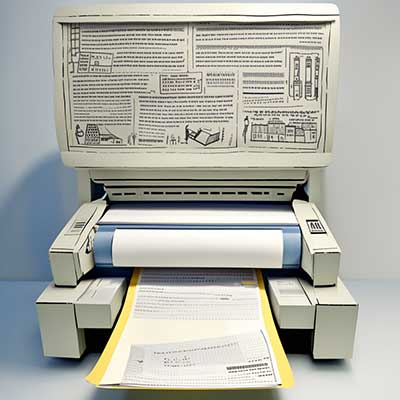The Evolution and Impact of Intelligent Document Processing
In today's rapidly evolving digital landscape, businesses are constantly on the lookout for innovative solutions to streamline operations and enhance efficiency. Enter Intelligent Document Processing (IDP) – a game-changer in the realm of document management. At its core, IDP harnesses the power of cutting-edge technologies to transform the way we handle, process, and interpret documents. Gone are the days of manual data entry and the tedious sifting through heaps of paperwork. With IDP, businesses can effortlessly automate document-related tasks, ensuring accuracy, speed, and a significant reduction in human error. And while the concept might sound futuristic, it's very much a reality today, with platforms like ThinkAutomation leading the charge. As we delve deeper into this article, we'll journey through the evolution of document processing, explore the myriad benefits of IDP, and provide insights into its real-world applications. Whether you're a seasoned professional or just dipping your toes into the world of automation, this guide promises to offer valuable insights and a fresh perspective on the transformative power of Intelligent Document Processing.

The Dawn of Document Processing
In the not-so-distant past, businesses were heavily reliant on manual methods for document processing. Picture a bustling office environment: employees hunched over desks, meticulously entering data into ledgers, and rifling through stacks of paperwork to locate a single piece of information. This was the era before digitalisation took hold, where every document, be it an invoice, a contract, or a customer record, was physically stored, often leading to cluttered workspaces and, more importantly, inefficiencies in data retrieval and management.
These manual methods, while standard for their time, posed a plethora of challenges. Human error was a constant concern, with the slightest oversight potentially leading to significant business repercussions. Moreover, the time-intensive nature of manual data entry meant that employees were often bogged down with routine tasks, leaving little room for strategic or creative endeavours.
But as with all things, change was on the horizon. The advent of computers and early automation tools began to reshape the landscape of document processing. Businesses started recognising the need for more efficient, error-free methods, setting the stage for the technological revolution in document management. And while these initial steps towards automation were transformative, they were merely the precursor to the sophisticated Intelligent Document Processing solutions we see today.
The Rise of Automation in Document Processing
As the digital age dawned, businesses began to witness the transformative potential of technology, especially in the realm of document processing. The cumbersome manual methods of yesteryears started giving way to more streamlined, automated solutions. Early software tools emerged, offering functionalities that were once thought impossible. From basic data entry systems to rudimentary document management platforms, the seeds of automation were sown.
These pioneering tools, while basic by today's standards, were revolutionary for their time. They allowed for quicker data input, reduced the risk of human error, and provided a semblance of organisation in the chaotic world of document management. The ability to digitally store, retrieve, and categorise documents was a significant leap forward, offering businesses newfound efficiencies and cost savings.
However, the true magic began when these tools started integrating with other systems. The synergy between different software platforms paved the way for more advanced automation capabilities. Processes that once took hours, if not days, could now be accomplished in mere minutes. And as these tools evolved, so did their intelligence, laying the groundwork for the next big leap in document processing: the advent of Intelligent Document Processing, a solution that would combine the power of automation with the sophistication of artificial intelligence.
The Mechanics of Intelligent Document Processing
Intelligent Document Processing isn't just a buzzword; it's a sophisticated blend of various technologies working in harmony. At its core, IDP leverages the power of artificial intelligence, machine learning, and natural language processing to understand, categorise, and process unstructured data within documents. This is a marked departure from traditional methods that often required manual intervention or could only handle structured data.
The process typically begins with the extraction of data from various document types. Advanced OCR (Optical Character Recognition) tools scan and convert printed or handwritten text into machine-encoded text. This data is then passed through AI algorithms that can identify patterns, categorise information, and even make decisions based on predefined criteria.
For businesses, the implications are profound. Imagine processing thousands of invoices, contracts, or emails in a fraction of the time it would take a human, and with increased accuracy. Beyond just efficiency, IDP offers scalability, ensuring that as your document processing needs grow, the system can handle the increased load without compromising on performance.
Moreover, with the integration of platforms like ThinkAutomation, businesses can further enhance the capabilities of IDP. By automating a wide range of tasks and integrating with various communication channels, the potential for streamlined operations becomes even more significant.


Real-World Applications of Intelligent Document Processing
Intelligent Document Processing (IDP) is not just a theoretical concept; it's making a significant impact across various sectors. Here's a glimpse into its real-world applications:
Healthcare: Hospitals and clinics are using IDP to digitize patient records, prescriptions, and diagnostic reports. This not only streamlines administrative tasks but also ensures that patient data is readily available for medical professionals.
Banking and Finance: IDP aids in processing loan applications, credit card statements, and other financial documents. It reduces errors, speeds up approval processes, and enhances customer service.
Legal Sector: Law firms are leveraging IDP to scan and categorize vast amounts of legal documents, helping lawyers quickly find relevant case information.
Retail: E-commerce giants use IDP to process invoices, receipts, and order forms, ensuring timely deliveries and accurate billing.
Education: Educational institutions are digitizing student records, transcripts, and other essential documents, making data retrieval more efficient.
Real Estate: Property documents, tenant agreements, and other crucial papers are being processed using IDP, reducing the time taken for property transactions.
Government: IDP is helping government agencies in digitizing citizen records, processing applications, and ensuring that public services are delivered efficiently.
The versatility of IDP ensures that no matter the sector, there's a potential application that can streamline operations, reduce costs, and improve service delivery.
Embracing IDP with ThinkAutomation
While the landscape of Intelligent Document Processing is vast and filled with numerous solutions, ThinkAutomation stands out as a comprehensive choice for businesses of all sizes. Here's why embracing IDP with ThinkAutomation is a strategic move for future-ready enterprises:
Holistic Integration:
ThinkAutomation seamlessly integrates with a myriad of platforms, ensuring that your document processing is not siloed but is a part of a cohesive digital ecosystem.
Customisable Workflows:
Every business is unique, and so are its document processing needs. ThinkAutomation offers customisable workflows, allowing businesses to tailor their IDP solutions precisely.
Scalability
The world of IDP is ever-evolving, and so is ThinkAutomation. Regular updates ensure that you always have access to the latest features and the best performance.
Security First:
In an age where data breaches are all too common, ThinkAutomation prioritises security. With robust encryption and stringent data protection measures, you can trust ThinkAutomation with your most sensitive documents.
Continuous Updates:
Whether you're a startup or a multinational corporation, ThinkAutomation scales with your needs. As your document processing requirements grow, ThinkAutomation is right there with you, ensuring consistent performance.
Dedicated Support:
A solution is only as good as the support behind it. ThinkAutomation boasts a dedicated support team, ensuring that any challenges you face are addressed promptly.
Choosing ThinkAutomation is choosing a future where document processing is not a chore but a strategic asset. It's about leveraging the power of IDP to drive business growth, efficiency, and innovation.
Intelligent Document Processing Quiz
The Future of Intelligent Document Processing
The world of Intelligent Document Processing is ever-evolving, driven by rapid advancements in technology and a growing demand for efficiency in business operations. As we look ahead, several trends and innovations promise to shape the future of IDP.
Adaptive Learning: As AI models become more sophisticated, they'll be better equipped to learn and adapt from the data they process. This means that over time, IDP systems will become even more accurate and efficient, reducing the need for human intervention.
Integration with IoT: The Internet of Things (IoT) is set to play a significant role in the future of IDP. Imagine sensors and smart devices automatically sending data to be processed, analysed, and acted upon in real-time.
Enhanced Security: As businesses handle more sensitive data, the security of IDP systems will become paramount. Advanced encryption, biometric verification, and blockchain integration are just a few of the technologies that will ensure data remains secure.
Cross-platform Compatibility: With the rise of remote work and diverse digital ecosystems, IDP solutions will need to be compatible across various platforms and devices. This will ensure seamless operations regardless of where employees are located or the devices they use.
Real-time Analytics: The ability to process and analyse documents in real-time will offer businesses a competitive edge. Immediate insights can lead to faster decision-making and more agile business operations.
The potential of IDP is vast, and its future is bright. As technology continues to advance, businesses that adopt and adapt to these changes will be best positioned to thrive in the digital age.

Implementing IDP in Your Business – Steps and Considerations
Implementing Intelligent Document Processing in your business can revolutionize your operations, but it requires careful planning and consideration. Here's a step-by-step guide:
Assessment:
Begin by assessing your current document processing methods. Identify areas that are time-consuming or prone to errors.
Define Objectives:
Clearly define what you aim to achieve with IDP. Having clear objectives will guide your implementation.
Choose the Right Solution:
Not all IDP solutions are created equal. Consider factors like scalability, integration capabilities, and user-friendliness when selecting a platform.
Training:
Ensure your team is adequately trained. This includes understanding the software and best practices for document management.
Integration:
Seamlessly integrate IDP with your existing systems. This might require collaboration with IT teams or external consultants.
Regular Review:
Continuously monitor the performance of your IDP system. Make adjustments as needed to ensure optimal performance.
Stay Updated:
The world of IDP is ever-evolving. Stay updated with the latest trends and advancements to ensure your business remains at the forefront.
Choosing ThinkAutomation is choosing a future where document processing is not a chore but a strategic asset. It's about leveraging the power of IDP to drive business growth, efficiency, and innovation.
